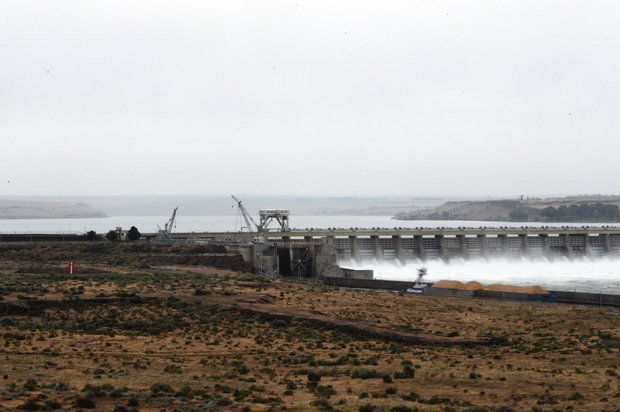forum
library
tutorial
contact

BPA Sets Rates for 2018-19; Includes Surcharge
to Recover Costs Associated with Increased Spill
by Staff
Columbia Basin Bulletin, July 28, 2017
|
the film forum library tutorial contact |

|
BPA Sets Rates for 2018-19; Includes Surcharge
by Staff
|
 This week the Bonneville Power Administration set rates for fiscal years 2018 and 2019 that, says the agency, "will help support long-term rate stability and maximize the value of the regional federal power and transmission systems."
This week the Bonneville Power Administration set rates for fiscal years 2018 and 2019 that, says the agency, "will help support long-term rate stability and maximize the value of the regional federal power and transmission systems."
BPA adopted a 5.4 percent average wholesale power rate increase and an average transmission rate decrease of 0.7 percent that will take effect Oct. 1.
In addition, BPA announced "a spill surcharge to recover the costs associated with increased spill that is anticipated as a result of a ruling issued this past spring by the U.S. District Court for the District of Oregon," said the agency in a press release.
"The court indicated that it will order increased spill at eight Federal Columbia River Power System dams on the lower Columbia and Snake rivers for the 2018 spring fish passage season. The surcharge will be in addition to the new power rates and will be implemented once sufficient information becomes available regarding planned annual spill levels. As part of the surcharge calculation, Bonneville is committed to working with its regional partners to find program cost savings, including in our Environment, Fish and Wildlife spending, to help offset the costs of increased spill."
(See CBB, April 7, 2017, "Court Order Requires Earlier Spill For Salmon In 2018; Orders Design Study, Monitoring" and CBB, June 23, 2017, "Litigants In Salmon BiOp Case Working Together To Develop Court-Ordered Spill-For-Fish Plan In 2018")
"We worked very hard on behalf of our customers to manage our costs and make changes that will strengthen our finances and improve our competitive position in the rapidly changing electricity market," said BPA Administrator and Chief Executive Officer Elliot Mainzer. "However, despite aggressive cost-management actions, costs beyond our direct control continue to place significant upward pressure on our power rates. BPA will further address these cost pressures through the completion of a long-term business strategy later this year in collaboration with customers and regional partners."
The 5.4 percent increase results in an average wholesale power rate of $35.57 per megawatt-hour, an increase of 2.7 percent annually.
"The overall rate increase is primarily due to a lower-than-expected demand for power, a declining forecast of surplus power sales revenues due to lower market prices, and escalating costs of programs driven by legal requirements. BPA is working with regional partners to identify new revenue streams and continued cost-containment strategies that may help mitigate these rising cost pressures," said the press release.
BPA has also adopted a new Financial Reserves Policy. This policy establishes a framework for setting and managing financial reserves levels to support BPA's credit ratings, liquidity, equity between business lines and rate stability. Approximately 1 percent of the power rate increase will be used to replenish Power's financial reserves levels, while transmission's financial reserves remain stable.
Transmission rates will decrease in the next rate period by an average of 0.7 percent. "This is due to cost-management efforts and savings from debt-management actions. Looking forward, BPA is working to address the significant impact of long-term capital costs and develop a sustainable investment strategy for pending transmission system capital needs," the agency said.
The new rates, said the press release, "also include investments to modernize core utility operating systems that will enable BPA to maximize the efficiency of grid operations and provide the option to participate in emerging markets."
"This rate case is ultimately about investing in our future and continuing to deliver value to our customers and the broader region for many years to come," said Mainzer.
BPA is a nonprofit federal wholesale utility and power marketer that receives no congressional appropriations and must recover its costs through its rates. The new rates will affect local retail utilities differently depending on the amount of power and type of services they purchase from BPA. Local utilities ultimately determine the impact of BPA's rates on individual businesses and residents.
BPA, headquartered in Portland, Oregon, sells wholesale electricity from 31 federal dams and one nuclear plant to 142 electric utilities, serving millions of consumers and businesses in Washington, Oregon, Idaho, western Montana and parts of California, Nevada, Utah and Wyoming. BPA delivers power via more than 15,000 circuit miles of lines and 260 substations to 511 transmission customers. In all, BPA markets about a third of the electricity consumed in the Northwest and operates three-quarters of the region's high-voltage transmission grid. BPA also funds one of the largest fish and wildlife programs in the world.
learn more on topics covered in the film
see the video
read the script
learn the songs
discussion forum
